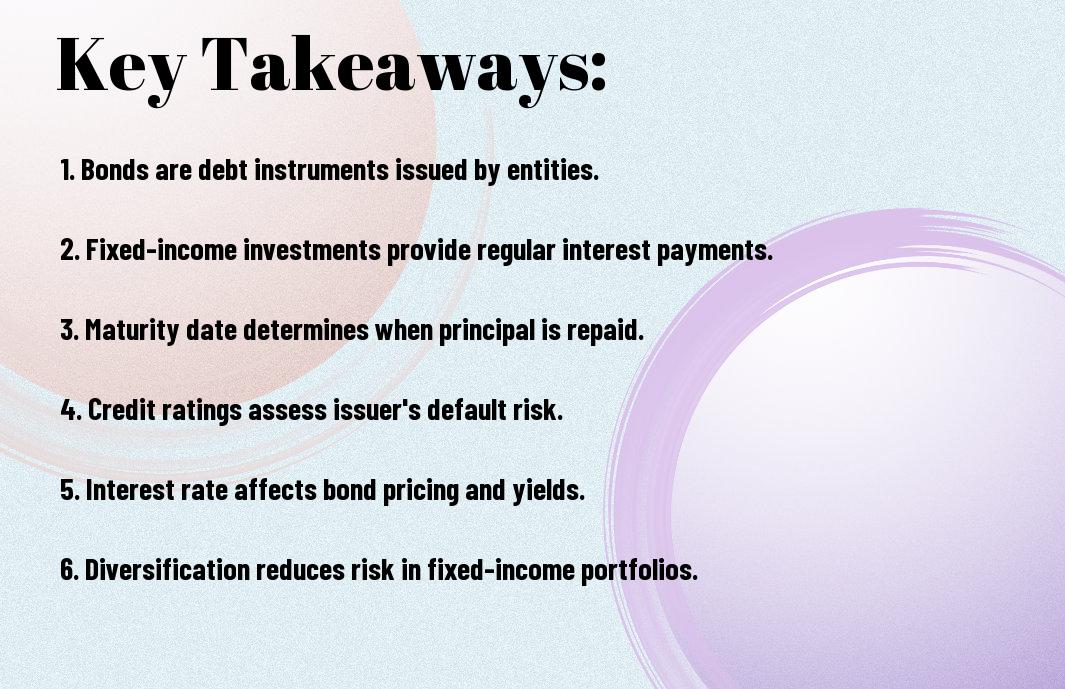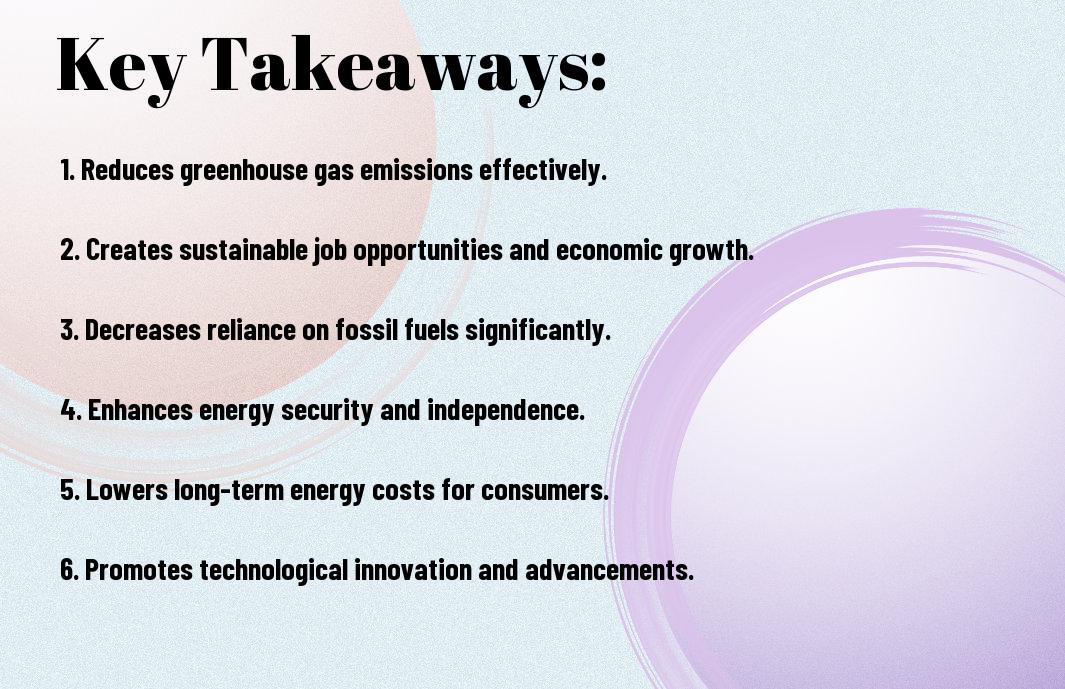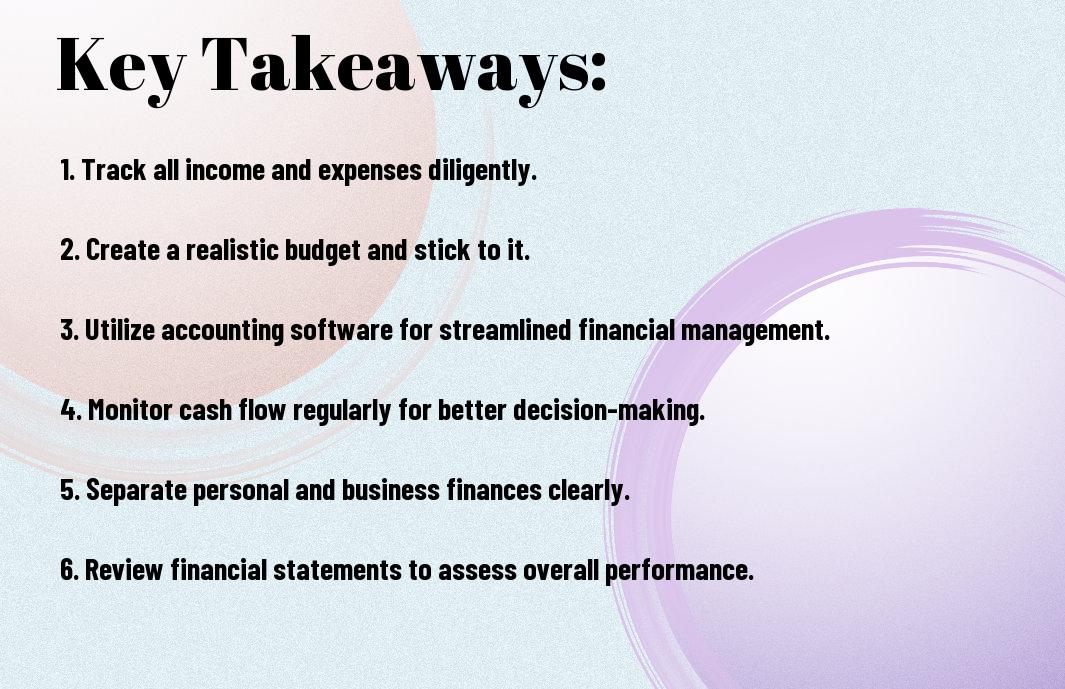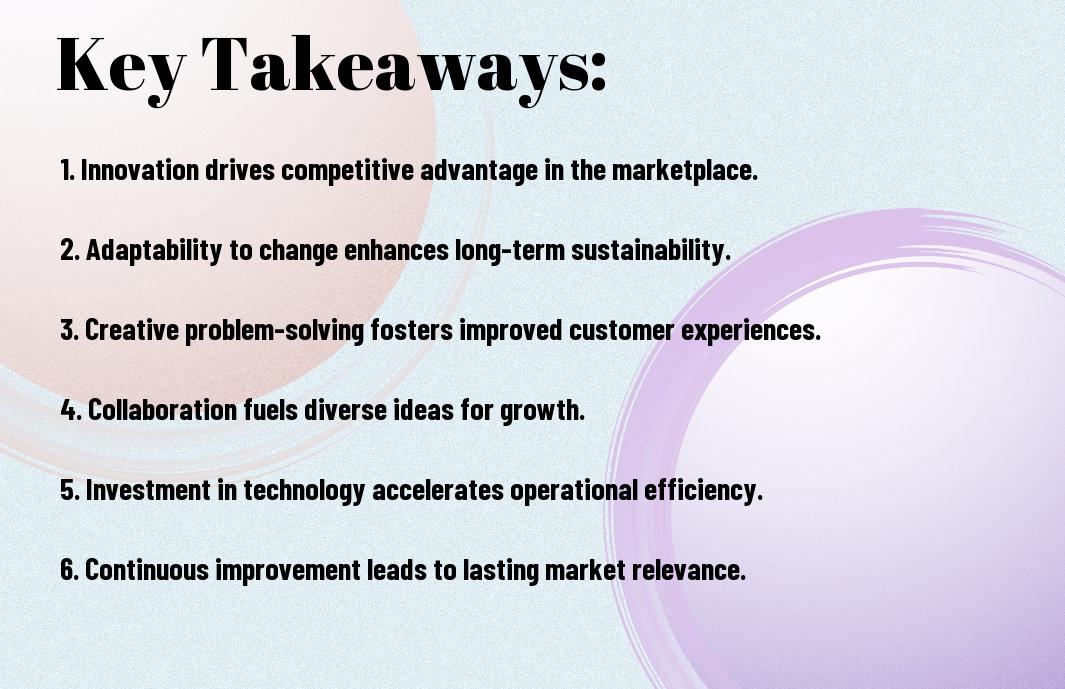You are entering the world of bonds and fixed-income investments, which can provide you with a stable and predictable revenue stream. Understanding these investment vehicles is important if you want to diversify your portfolio and mitigate risk. In this post, you will learn what bonds are, how they work, and the different types of fixed-income options available to you. By the end, you’ll have a solid foundation that empowers you to make informed investment decisions.
Key Takeaways:
- Definition: Bonds are debt instruments used by governments and corporations to raise capital, wherein investors lend money in exchange for periodic interest payments and the return of the bond’s face value at maturity.
- Types of Bonds: There are various types, including government bonds, municipal bonds, and corporate bonds, each serving different investment needs and risk profiles.
- Interest Rates: Bond prices are inversely related to interest rates; when interest rates rise, bond prices typically fall, and vice versa, impacting their overall return.
- Credit Risk: Assess the credit quality of bonds, as bonds with lower ratings offer higher yields but pose greater risks of default.
- Diversification: Including bonds in an investment portfolio can help enhance stability and reduce overall risk, providing a counterbalance to more volatile equity investments.

Understanding Bonds
The realm of bonds and fixed-income investments offers a pathway to stable returns and portfolio diversification. These financial instruments serve as loans from investors to borrowers—typically governments or corporations—where you earn interest over time and receive your principal back at maturity.
What is a Bond?
Between the issuer and the investor, a bond represents a debt obligation where the issuer promises to return the face value at maturity while paying periodic interest—known as the coupon—throughout the bond’s life.
Types of Bonds
After understanding the basics, you can explore various types of bonds, each serving unique investment strategies and risk profiles:
| Government Bonds | Issued by national governments, generally low-risk. |
| Corporate Bonds | Issued by companies, can offer higher returns but with more risk. |
| Muni Bonds | Issued by municipalities, often tax-exempt. |
| Zero-Coupon Bonds | Sold at a discount, pay no interest until maturity. |
| High-Yield Bonds | Lower credit ratings, higher return potential. |
Knowing the types of bonds helps you align your investment choices with your financial goals and risk tolerance.
More about Types of Bonds
For instance, corporate bonds often provide higher yields compared to government bonds due to the increased risk of default associated with corporations. Understanding their characteristics can aid you in constructing a balanced portfolio. Here’s a more detailed look at the types:
| Convertible Bonds | Can be converted into a predetermined number of shares. |
| Inflation-Linked Bonds | Interest payments rise with inflation. |
| Foreign Bonds | Issued by foreign governments or corporations, subject to currency risk. |
| Bonds with Call Options | Issuer can redeem them before maturity. |
| Sukuk | Islamic equivalent of bonds, compliant with Sharia law. |
Knowing the right type of bond for your financial situation can greatly enhance your investment strategy and outcomes.
Fixed-Income Investments Defined
Some investors might wonder what fixed-income investments are and how they differ from other securities. Essentially, fixed-income investments are financial instruments that provide a fixed return over a specified period, typically through interest payments. For a comprehensive understanding, you can check out Bonds 101: The What and Why of Bond Investing.
Characteristics of Fixed-Income Investments
For you to recognize fixed-income investments, they usually exhibit specific characteristics, such as predictable cash flows, lower volatility compared to equities, and varying maturity periods. These investments include bonds, treasury bills, and preferred stocks, all offering distinct risk and return profiles.
Importance of Fixed-Income in a Portfolio
Investments in fixed-income options play a significant role in diversifying your investment portfolio. They can provide stability and a steady income stream, acting as a buffer against market volatility. Additionally, fixed-income securities often behave differently than stocks, which can enhance your overall risk-adjusted returns.
A well-balanced portfolio typically includes a mix of assets, and incorporating fixed-income investments can help you achieve your financial goals. By providing consistent returns, they can alleviate the impact of unpredictable stock market changes, ensuring that you have a reliable source of income, especially during retirement. Understanding the balance between risk and return is important for developing an investment strategy that meets your needs.
Yield and Interest Rates
Unlike stocks, where returns are influenced by company performance and market trends, the yield on bonds reflects the expected income you receive from your investment relative to its price. This relationship between bond prices and yields means that as interest rates fluctuate, so too does the yield on your bond investments, impacting your overall returns.
Understanding Yield
Behind the concept of yield lies the imperative role it plays in fixed-income investments. Yield represents the income return you can expect from a bond, typically expressed as an annual percentage. Yield helps you compare different types of bonds and understand the potential return relative to the investment you make.
The Impact of Interest Rates on Bonds
Beside influencing yield, interest rates play a key role in determining bond prices. When market interest rates rise, the value of existing bonds generally falls, as new bonds are issued with higher yields, making your current holdings less attractive. Conversely, if interest rates decline, bond prices typically increase, enhancing the appeal of your fixed-income investments.
In addition, the timing of interest rate changes can significantly affect your bond investment strategy. If you anticipate rising interest rates, you might consider holding shorter-duration bonds, which are less sensitive to rate changes. Alternatively, if rates are projected to drop, longer-duration bonds may offer you the benefit of locking in higher yields for an extended period. By staying informed about interest rate trends, you can make more strategic decisions regarding your bond portfolio.
Risks Associated with Bonds and Fixed-Income Investments
Now that you understand the basics of bonds, it’s vital to be aware of the risks linked to these investments. While bonds are generally perceived as safer than equities, they are not without their pitfalls. Factors such as credit risk, interest rate risk, and inflation can all affect your bond’s performance and overall returns. By gaining a solid understanding of these risks, you can make more informed decisions regarding your fixed-income investments.
Credit Risk
Associated with bond investing is credit risk, which refers to the possibility that the issuer may default on interest or principal payments. This risk is particularly relevant for corporate bonds, as companies can face financial difficulties that may lead to default. Evaluating the credit rating of the issuer can help you assess the level of risk involved and guide your investment choices accordingly.
Interest Rate Risk
With fixed-income investments, you also face interest rate risk, which stems from changes in prevailing interest rates. When interest rates rise, the market value of existing bonds typically declines, as new bonds are issued at higher rates, making older bonds less attractive. This situation can lead to potential losses if you need to sell your bonds before maturity.
The relationship between bond prices and interest rates means that you should be particularly mindful of the market’s direction. If you hold bonds with longer maturities, this risk may be more pronounced, as they are more sensitive to interest rate fluctuations. Conversely, shorter-duration bonds tend to have less volatility in response to interest rate changes. By strategically managing your bond portfolio and considering your investment horizon, you can help mitigate the impact of interest rate risk on your overall returns.
Bond Valuation
Despite the complexity of bond valuation, understanding its principles is vital for investors like you. The valuation process enables you to determine the fair price of a bond based on its expected future cash flows. To deepen your knowledge, consult this Guide to Fixed Income: Types and How to Invest, which provides detailed insights into fixed-income securities.
Pricing of Bonds
Around the world of finance, bond pricing is influenced by various factors, including interest rates, credit ratings, and the bond’s term to maturity. The bond’s price is vitally the present value of its future cash flows, which consist of coupon payments and the principal repayment at maturity. As these factors fluctuate, so too does the bond’s market price, which you should consider carefully when making investment decisions.
Yield to Maturity
Around the journey of fixed-income investing, yield to maturity (YTM) plays a significant role. YTM represents the total return you will earn if you hold the bond until it matures, taking into account all coupon payments and any gain or loss incurred upon maturity. It is a helpful metric for comparing the attractiveness of various bonds.
Bonds offer a predictable stream of income, which is why understanding yield to maturity is vital for your investment strategy. Calculating YTM involves considering the bond’s current market price, its coupon payments, and the time left until maturity. This vital metric helps you assess whether a bond’s potential return aligns with your investment goals, allowing you to make informed decisions in the fixed-income market.

Strategies for Investing in Bonds
Many investors utilize various strategies to optimize their fixed-income portfolios. Understanding different approaches can enhance your bond investments and align them with your financial goals. From simple buy-and-hold strategies to more sophisticated methods like laddering and diversification, each tactic has its own benefits. Choosing the right strategy depends on your investment timeline, risk tolerance, and market conditions.
Buy and Hold Strategy
About the buy-and-hold strategy, you focus on purchasing bonds and maintaining them until maturity. This method provides predictable income through interest payments, allowing you to reduce transaction costs and minimize market timing risks. By holding until maturity, you can capitalize on the bond’s face value, regardless of fluctuations in the market.
Laddering and Diversification
Below, laddering and diversification involve spreading your investments across multiple bonds of varying maturities and types. This approach helps manage interest rate risk while maximizing returns based on changing market conditions.
Also, by constructing a bond ladder, you stagger maturity dates to ensure that some of your investments are maturing regularly, providing liquidity and enabling you to reinvest at current rates. Diversifying your bond holdings can also mitigate risks associated with individual bonds, as different types react differently to market shifts. Thus, combining both strategies allows you to build a more resilient and productive fixed-income portfolio.
Final Words
Conclusively, understanding the basics of bonds and fixed-income investments equips you with the knowledge to make informed financial decisions. By recognizing the types of bonds available, their benefits, and the associated risks, you can effectively diversify your portfolio to meet your investment goals. Fixed-income investments can provide stability and predictable income, making them an imperative component of your financial strategy. As you navigate this investment landscape, stay informed and assess your risk tolerance to optimize your approach to bonds.
FAQ
Q: What are bonds and how do they work?
A: Bonds are fixed-income securities that represent a loan made by an investor to a borrower, typically corporate or governmental. When you buy a bond, you are effectively lending money to the issuer in exchange for periodic interest payments, known as coupon payments, and the return of the bond’s face value when it matures. The interest rate on the bond, its maturity date, and the creditworthiness of the issuing entity all play significant roles in determining the bond’s price and investment appeal.
Q: What are the different types of bonds available for investors?
A: There are several types of bonds available, each serving different purposes and risk profiles. Common types include government bonds (Treasuries, municipal bonds) which are generally considered low-risk; corporate bonds which are issued by companies and usually offer higher yields but come with increased risk; and high-yield (or junk) bonds that offer higher returns due to a higher risk of default. There are also hybrid options like convertible bonds, which can be converted into equity under certain conditions. Each type of bond has unique attributes and should align with an investor’s goals and risk tolerance.
Q: How can an investor assess the risk associated with bonds?
A: Assessing the risk of bonds involves considering multiple factors, including the credit rating of the issuer, the bond’s duration, and prevailing interest rates. Credit rating agencies provide ratings that indicate the default risk of an issuer; higher-rated bonds (investment-grade) are considered safer than lower-rated (junk) bonds. Duration measures a bond’s sensitivity to interest rate changes; longer duration means higher sensitivity to rate fluctuations. Additionally, keeping an eye on economic conditions can help investors gauge overall market risk. Diversifying a bond portfolio can also mitigate risks associated with individual bond investments.







